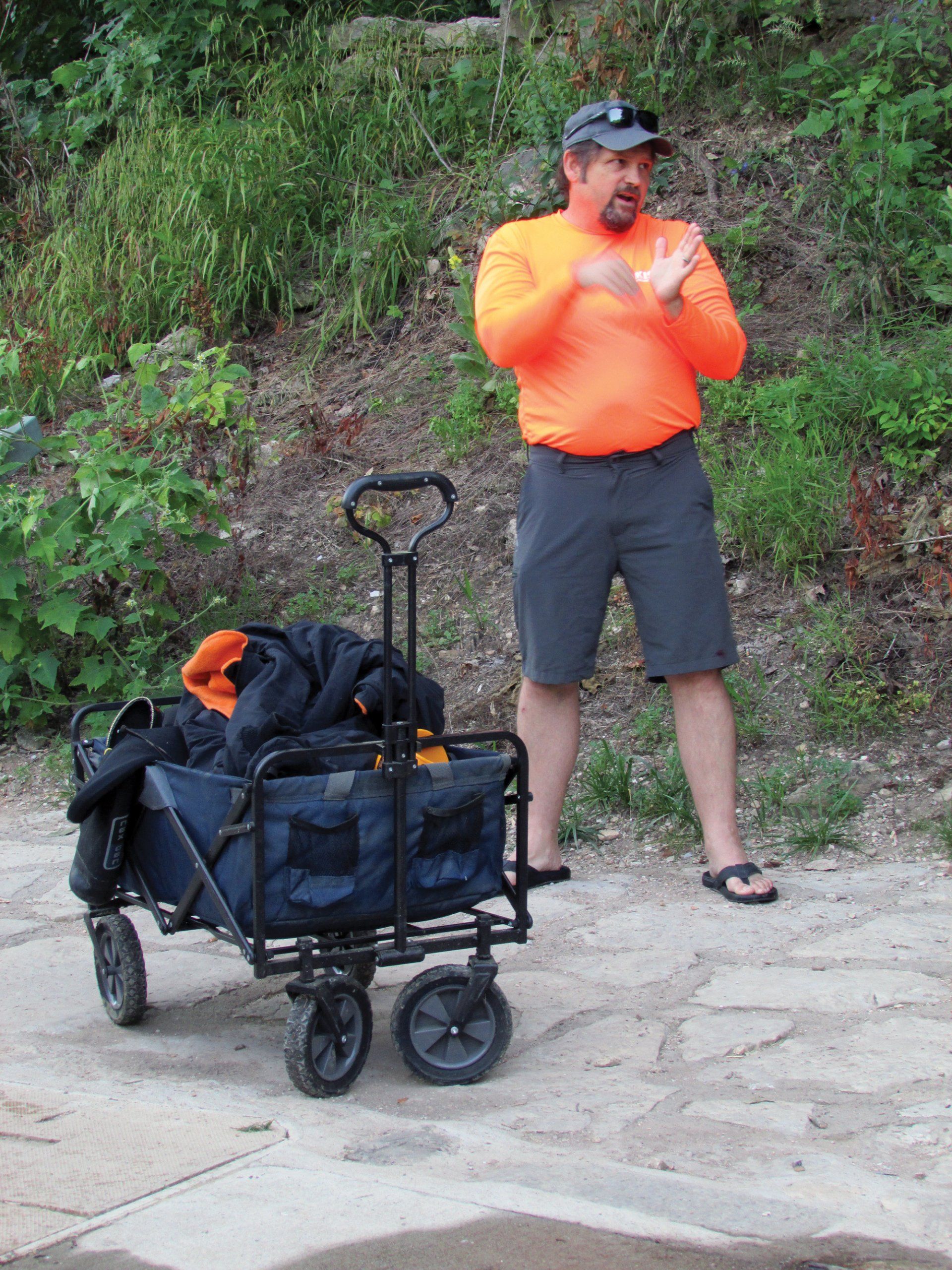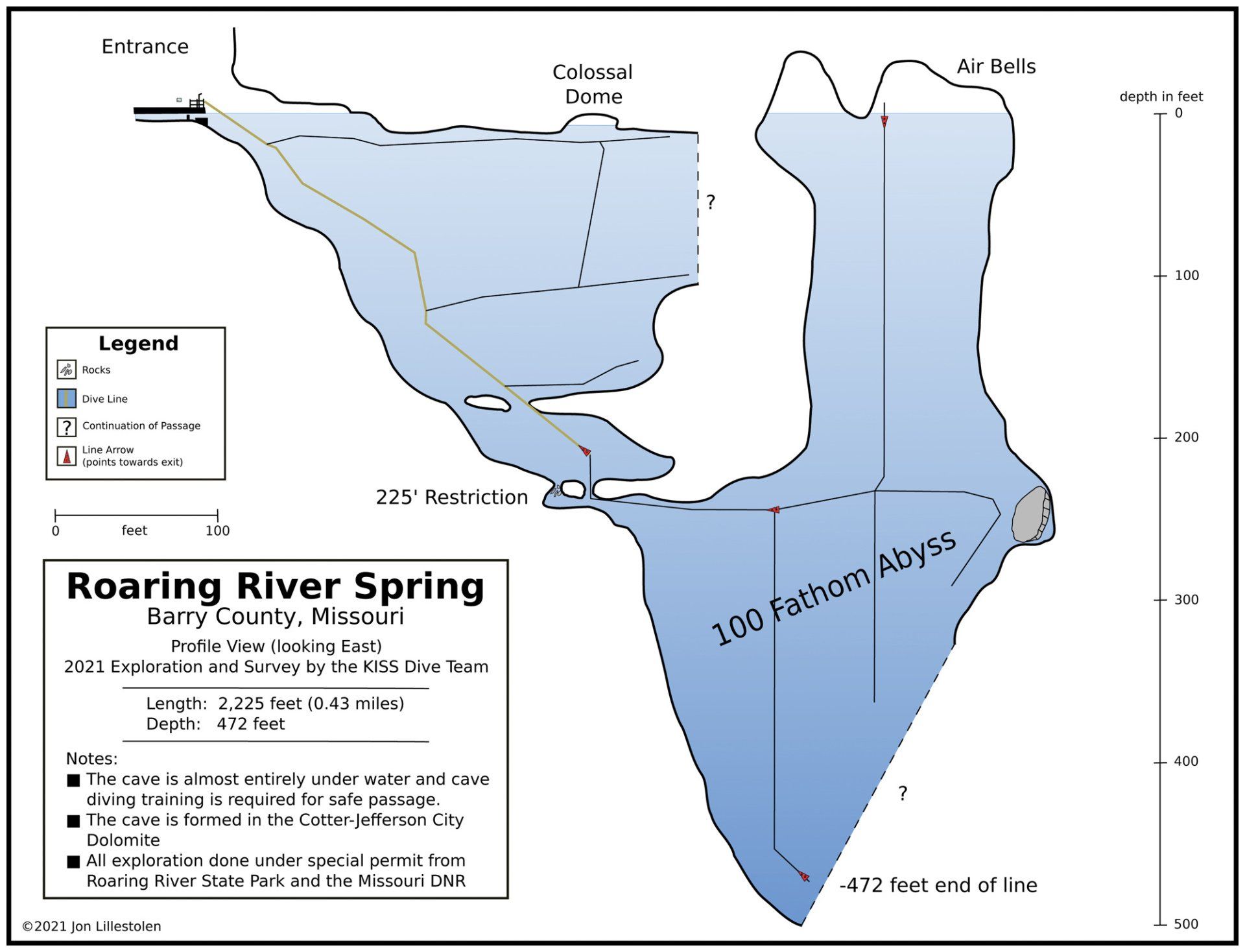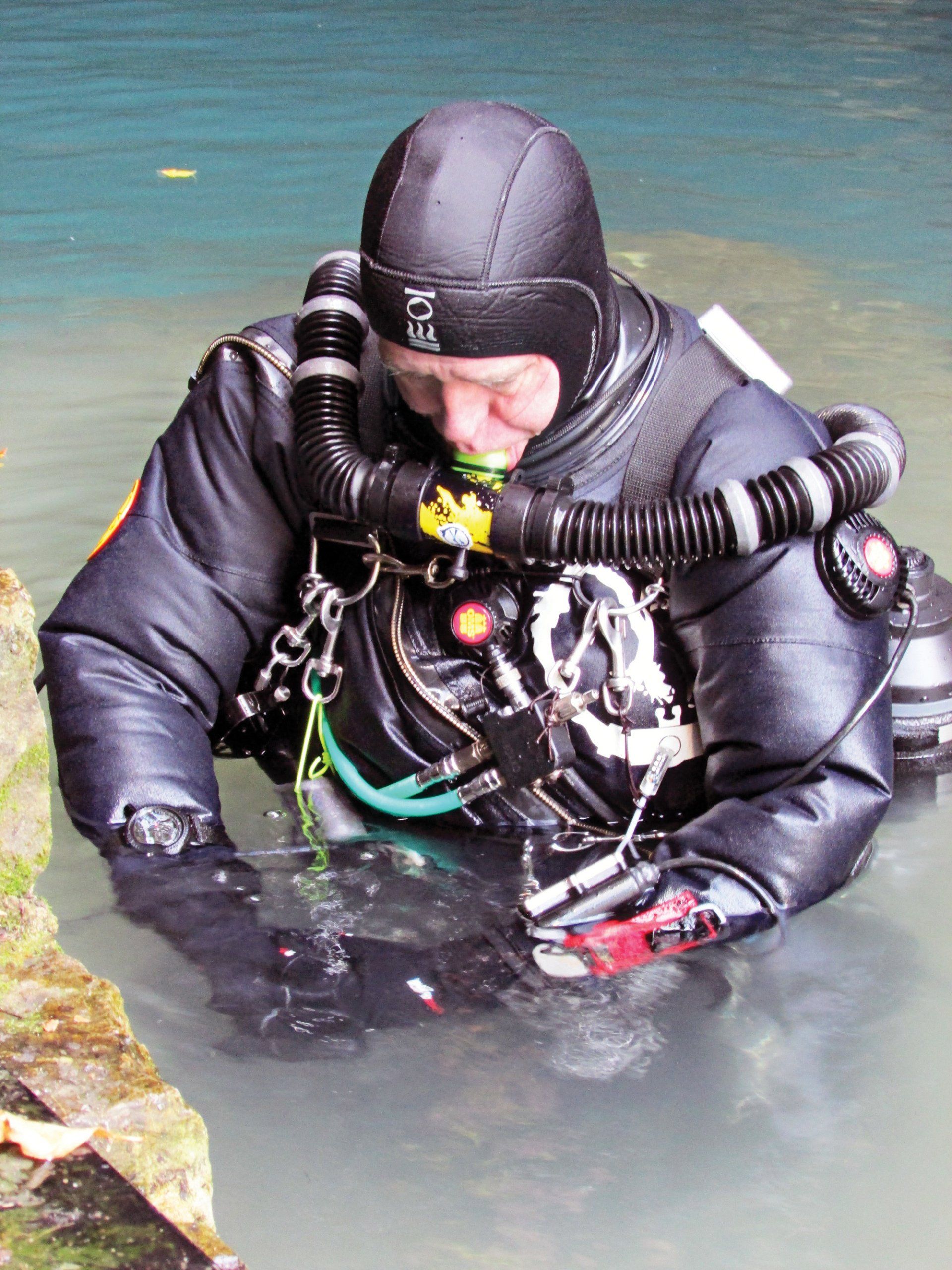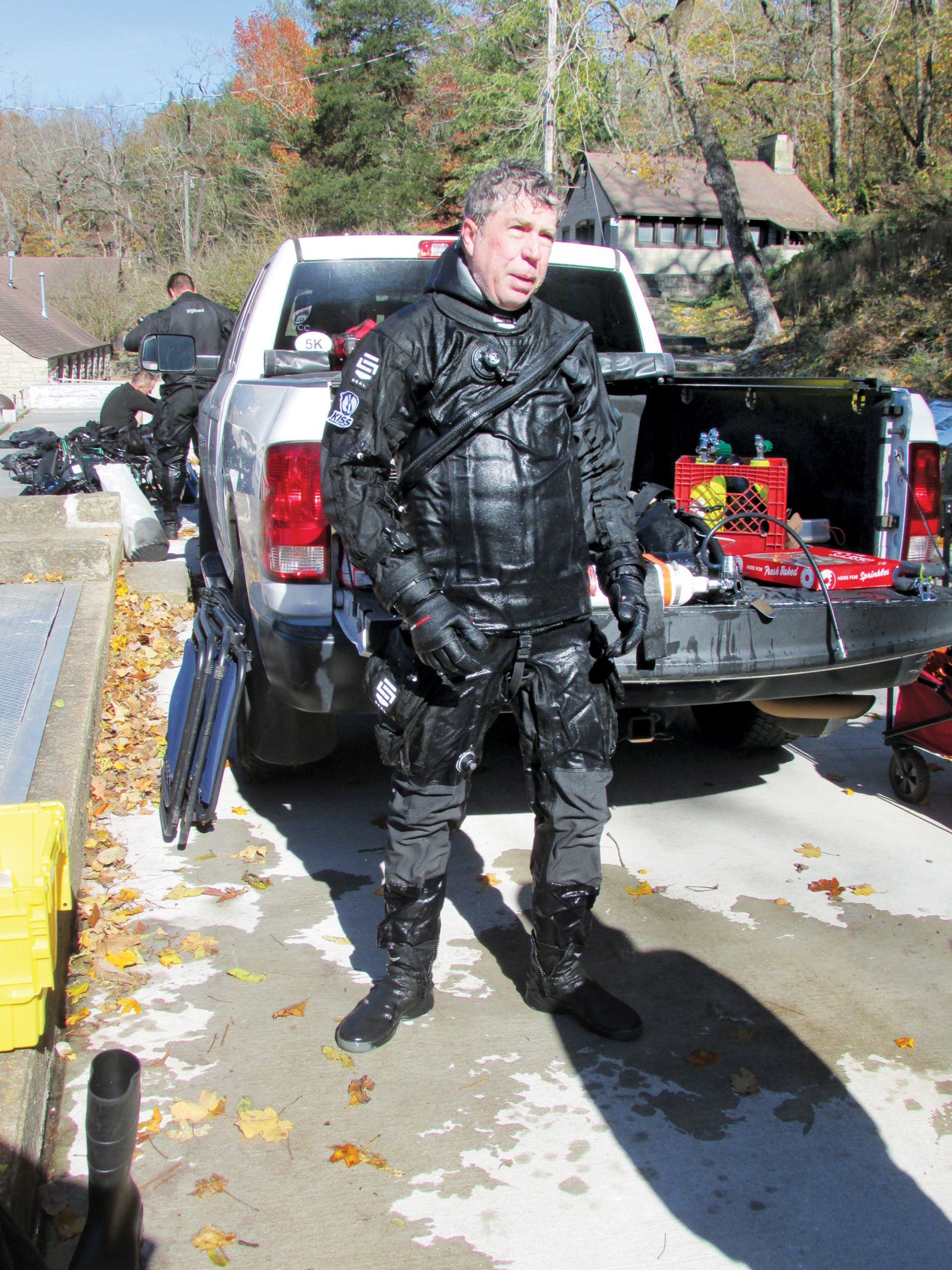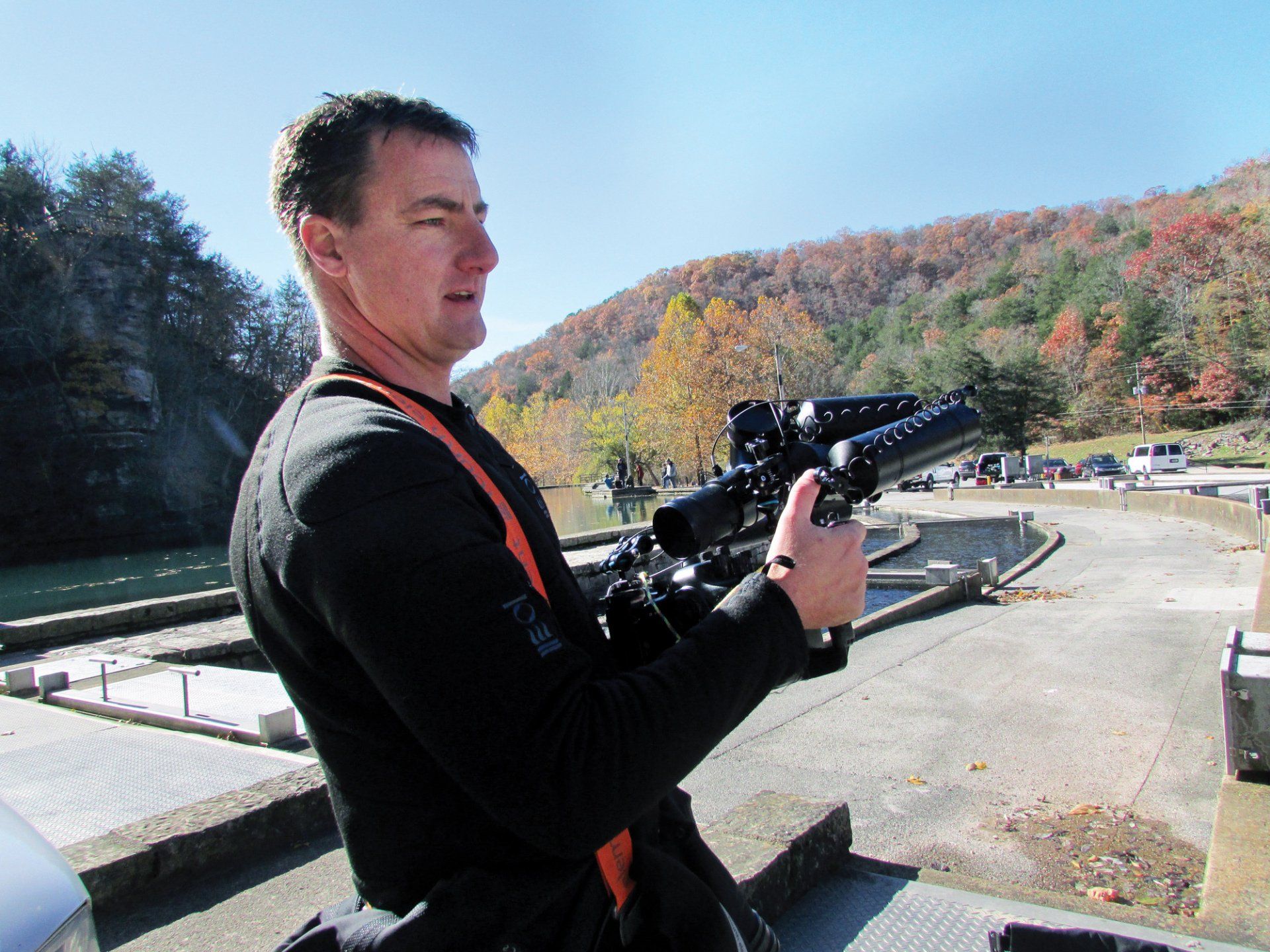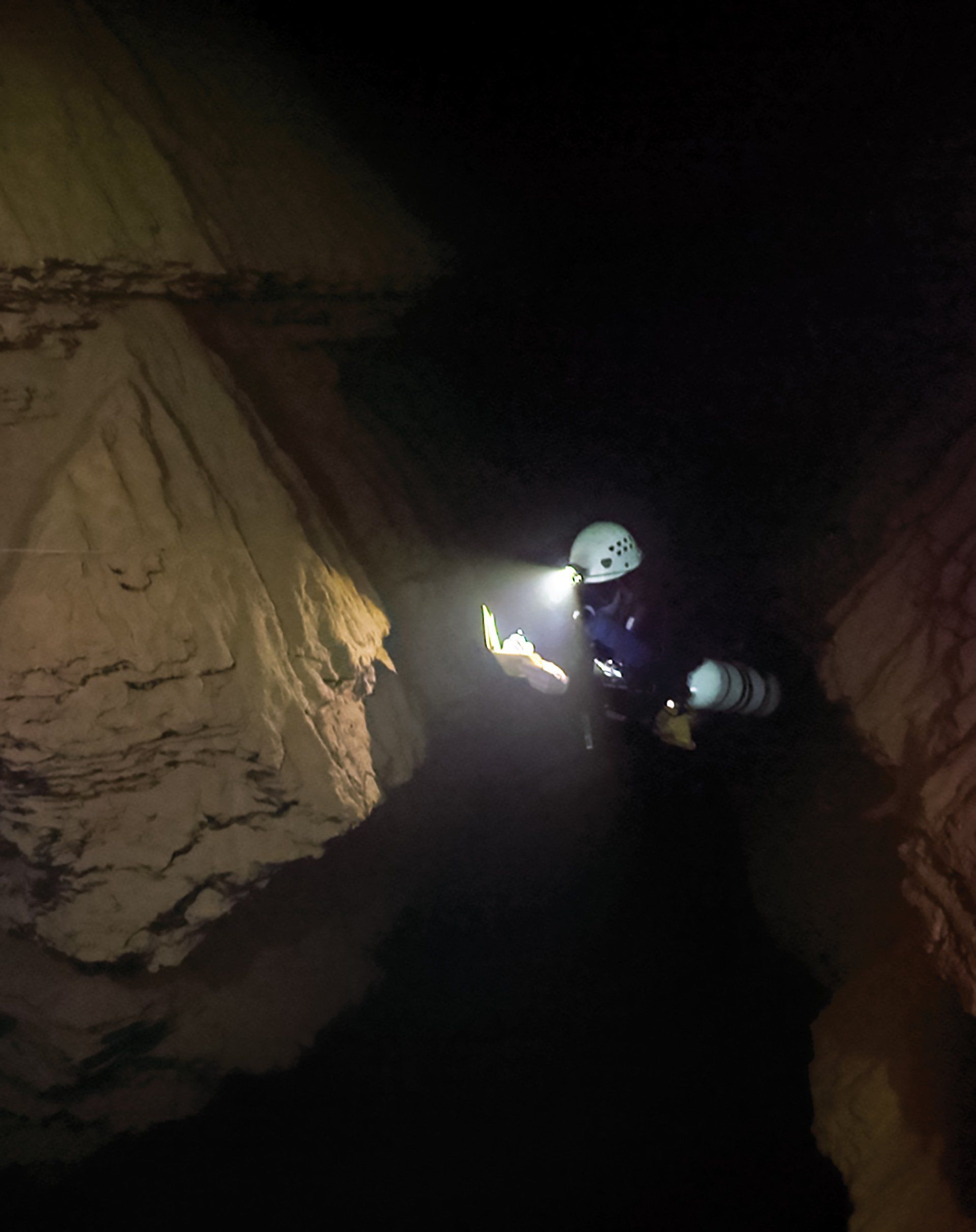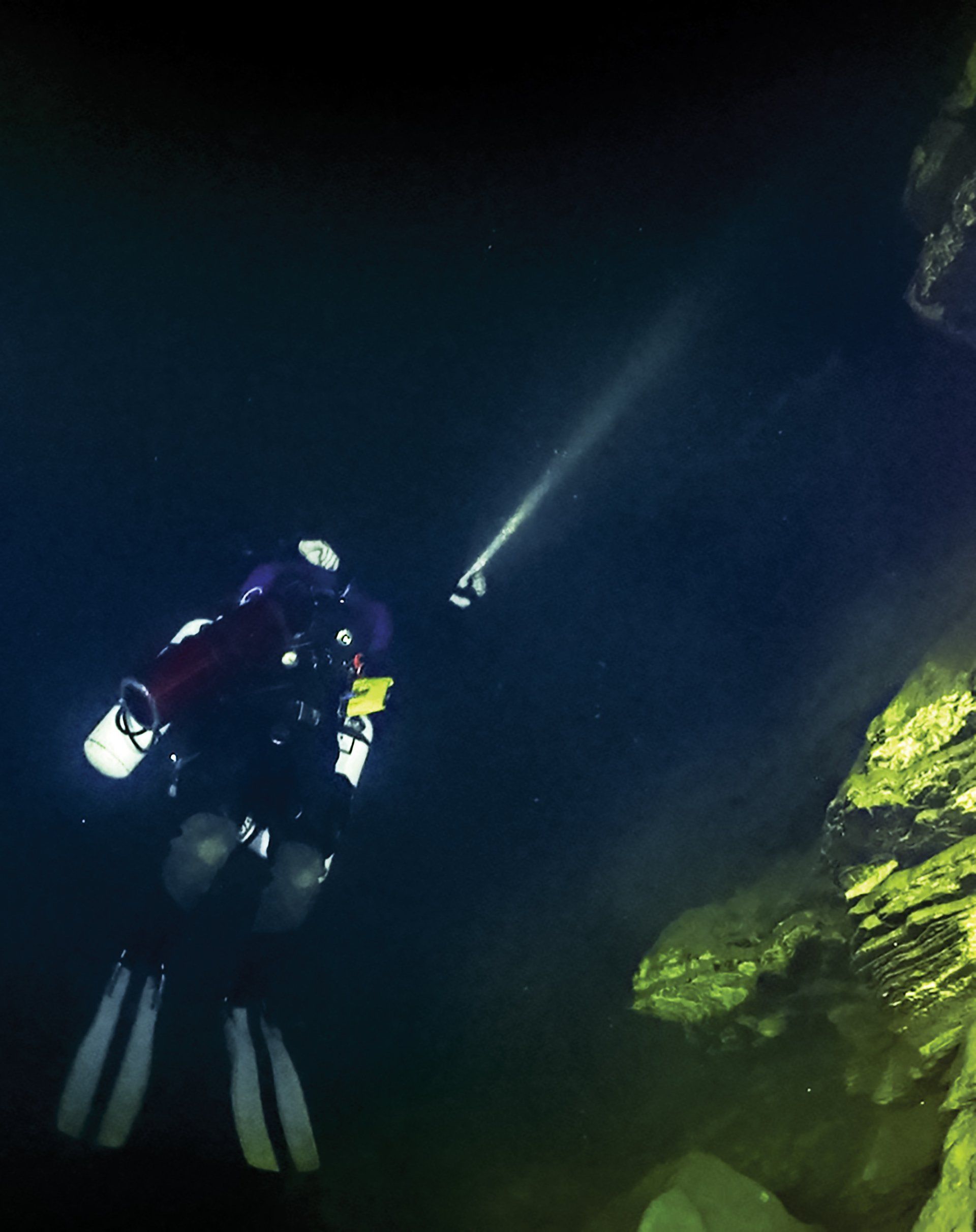Pictured is a new map of below the spring at Roaring River, showing where KISS Rebreathers divers have explored.
With the blessings of Roaring River State Park officials and the Missouri Department of Natural Resources (DNR), a team of divers from KISS Rebreathers, in Fort Smith, Ark., made a series of monthly, weekend dives into Roaring River Spring from May through November of 2021.
During their explorations, they put Roaring River Spring firmly on the map as the deepest spring in Missouri and the deepest explored spring in the nation by achieving a depth of 472 feet sub-surface during their final dive of the season in November.
KISS Rebreathers head diver and CEO Mike Young continues surface decompression after an October dive into Roaring River Spring.
According to “Caving News,” the previous national depth-record of 462 feet was set at Phantom Spring Cave in West Texas in 2013.
Mike Young, head diver and CEO of KISS Rebreathers, says the record-breaking dive into Roaring River Spring was only possible because of the advances in technology made since the cave was initially explored by divers Roger Miller and Frank Fogarty in 1979, and again in the early 1990s by a different team.
“Traditional SCUBA equipment involves bulky air tanks divers carry on their backs,” Young said. “The large tanks prevented earlier divers from going through the narrow restriction that exists at a depth of 224 feet in the cave.”
According to Young, the advanced diving equipment used by the KISS Rebreathers team is much more compact because it scrubs the CO2 from a diver’s exhaled air and allows them to reuse the oxygen. Several different models of rebreathers are custom-manufactured at Young’s KISS Rebreathers facility in Fort Smith, Ark..
Among diving circles, Young is world-renowned for his underwater cave explorations which include what is believed to be the world’s longest underground river in Puerto Rico, as well as submerged cave systems in Mexico. In Missouri and Arkansas, Young has explored Roubidoux Spring, near Waynesville, and Blue Spring, west of Eureka Springs, Ark.
KISS Rebreathers head diver and CEO, Mike Young, of Fort Smith, Ark., answers questions from the public after his national-record-breaking dive into Roaring River Spring on Nov. 14, 2021. Photo by Sheila Harris
The KISS Rebreathers team is made up of divers from around the nation – and world — who assemble at a particular exploration site for scheduled dives.
For the Roaring River Cave exploration, Randall Purdy, of Kearney, Neb., is the designated chief underwater photographer. Purdy, who owns a diving and underwater photography business in Kearney, recently invested in a new camera specifically for use in Roaring River Spring as greater depths were achieved.
“My previous camera was only rated for a depth of 330 feet,” Purdy said. “If I’d taken it below that depth, it would have imploded.”
Purdy’s new camera, rated for a depth of 600 feet, is being used to create videos: a shorter one for use in the Ozark Chinquapin Nature Center at Roaring River State Park and a longer, full-length documentary for intended future publication. Both the shorter and longer videos are being produced by TL Bass Telepictures of Bentonville, Ark., and include interviews with the divers as well as sub-surface footage of cave explorations.
KISS Rebreathers chief underwater photographer, Randall Purdy, of Kearney, Neb., displays the new camera he purchased in order to record footage of the national-record-breaking dive into Roaring River Spring on Nov. 14, 2021. The camera is rated for a depth of 600 feet sub-surface. Photo by Sheila Harris
“The documentary will also include plenty of history of the Roaring River area and interviews with local residents,” said Tim Bass, owner of TL Bass Telepictures. “We want to make it appealing to the population in general, not just to those interested in the diving aspect.”
Plumbing the depth of the spring and the creation of video productions are only part of the mission of the divers, though. According to Joel Topham, Roaring River Stat Park natural resource manager, the remapping of the cave below the water’s surface is also important to the park and to the DNR.
“With newer satellite technology, we’re hoping to learn more about what the cave’s underground footprint looks like,” he said.
KISS Rebreathers diver and cartographer, Jon Lillestolen, of Blacksburg, Va., is instrumental in the mapping of the cave’s underwater dimensions. He has been consistently aided in his efforts by the team’s only female diver, Gayle Orner, of Madison, Wis.
New Dives are scheduled, weather-permitting,
for the following dates in 2022:
March 10-13
April 7-10
May 19-22
June 9-12
July 7-10
Aug. 18-21
Sept. 15-18
Oct. 13-16
Nov. 10-13
Jon Lillestolen, of Blacksburg, Va., diver/cartographer with KISS Rebreathers, based in Fort Smith, Ark., check his map during a dive in the Roaring River spring. Photo by Randall Purdy Photography, courtesy of TL Bass Telepictures
“We use a system of lines and knots [tied at 10-foot intervals] to measure the underwater dimensions and configuration of the cave,” Lillestolen said.
While underwater, Lillestolen manually records the measurements in a small notebook. When back on terra firma, he creates hand-drawn sketches from the measurements, transcribes the numbers into his computer, then creates visual models of the underwater appearance of the cave.
A 3-D model is currently being created for release by Roaring River State Park in the near future.
“We plan to replace the old map beside the mouth of the spring with a new one created by the divers,” Topham said.
According to Young, during the early part of 2022, the divers will focus on mapping efforts.
Jon Lillestolen, of Blacksburg, Va., diver/cartographer with KISS Rebreathers, based in Fort Smith, Ark., comes back to the surface after a dive into the Roaring River spring. Photo by Randall Purdy Photography, courtesy of TL Bass Telepictures
Purdy said due to typical spring rains which increase the water flow, the divers may not be able to penetrate the restriction at the 224-foot depth-mark in the cave until later in the season, maybe June.
In 2021, the divers were not able to penetrate the restriction until July, at which point the water flow had subsided to about 50 cubic feet per second (CFS) after spring flooding had taken it up to 250 CFS and beyond.
Beyond the restriction, Young and Lillestolen found a room so large that no walls nor floors could be seen.
“Even the ceiling, which we followed for several feet, disappeared, too,” Young said. “It’s scary big in there.”
Purdy said the cavern is big enough to contain a 40-story building.
According to Young, at the record-breaking depth of 472 feet, achieved in November, that large room had slimmed to a narrower passageway.
“We may be nearing the spring’s source tunnel,” he said.
While the KISS Rebreathers have made dives into the spring appear easy, they are not for the inexperienced. The record 472-foot dive required a total of about three hours of diving time, plus multiple auxiliary tanks of different mixes of compressed air staged along underwater lines enroute to their destination.
“Most of the diving time was spent on necessary decompression before resurfacing,” Young said. “It’s the most boring part of the dive.”
According to Purdy, he and Young achieved the 472-foot depth and were back up to the restriction within 29 minutes. The rest of the time was spent decompressing at various depths to prevent decompression sickness – even possible death.
Diver/Cartographer Jon Lillestolen, right, of Blacksburg, Va., receives an equipment adjustment from KISS Rebreathers teammate Greg Ables, of Fort Smith, Ark., in preparation for a July dive into Roaring River Spring.
Safety measures play a huge part in each dive. Registered nurse and first responder Neil Brownlow, of Fort Smith, Ark., is the team’s designated safety diver. He dives last into the spring and makes periodic, shorter dives thereafter to determine that all is well sub-surface.
Diver and surface manager Tony Bryant, also of Fort Smith, remains on the ground and keeps detailed records of each diver’s dive-plan by noting the time they enter the water and the time of their expected return. If a diver does not return topside according to his or her schedule, Bryant will immediately alert others of a potential problem.
KISS Rebreathers safety diver, Neil Brownlow, of Fort Smith, Ark., explains the plan for a June dive into Roaring River Spring to interested visitors.
While a few of the divers experienced glitches with the function of their equipment or apparel last year, most of the problems were caught near the surface and simply meant an aborted dive for the individuals involved.
With the renewal of permits from the DNR, the exploration of Roaring River Cave by the KISS Rebreathers team will continue throughout 2022. Their first dive of the year was scheduled for mid-February, with the second one on tap for March 10-13, weather-permitting.
“There’s still plenty of cave down there to explore,” Young said.
According to “Caving News,” the previous national depth-record of 462 feet was set at Phantom Spring Cave in West Texas in 2013.
Mike Young, head diver and CEO of KISS Rebreathers, says the record-breaking dive into Roaring River Spring was only possible because of the advances in technology made since the cave was initially explored by divers Roger Miller and Frank Fogarty in 1979, and again in the early 1990s by a different team.
“Traditional SCUBA equipment involves bulky air tanks divers carry on their backs,” Young said. “The large tanks prevented earlier divers from going through the narrow restriction that exists at a depth of 224 feet in the cave.”
According to Young, the advanced diving equipment used by the KISS Rebreathers team is much more compact because it scrubs the CO2 from a diver’s exhaled air and allows them to reuse the oxygen. Several different models of rebreathers are custom-manufactured at Young’s KISS Rebreathers facility in Fort Smith, Ark.
Among diving circles, Young is world-renowned for his underwater cave explorations which include what is believed to be the world’s longest underground river in Puerto Rico, as well as submerged cave systems in Mexico. In Missouri and Arkansas, Young has explored Roubidoux Spring, near Waynesville, and Blue Spring, west of Eureka Springs, Ark.
The KISS Rebreathers team is made up of divers from around the nation – and world — who assemble at a particular exploration site for scheduled dives.
For the Roaring River Cave exploration, Randall Purdy, of Kearney, Neb., is the designated chief underwater
photographer. Purdy, who owns a diving and underwater photography business in Kearney, recently invested in a new camera specifically for use in Roaring River Spring as greater depths were achieved.
“My previous camera was only rated for a depth of 330 feet,” Purdy said. “If I’d taken it below that depth, it would have imploded.”
Purdy’s new camera, rated for a depth of 600 feet, is being used to create videos: a shorter one for use in the Ozark Chinquapin Nature Center at Roaring River State Park and a longer, full-length documentary for intended future publication. Both the shorter and longer videos are being produced by TL Bass Telepictures of Bentonville, Ark., and include interviews with the divers as well as sub-surface footage of cave explorations.
“The documentary will also include plenty of history of the Roaring River area and interviews with local residents,” said Tim Bass, owner of TL Bass Telepictures. “We want to make it appealing to the population in general, not just to those interested in the diving aspect.”
Plumbing the depth of the spring and the creation of video productions are only part of the mission of the divers, though. According to Joel Topham, Roaring River Stat Park natural resource manager, the remapping of the cave below the water’s surface is also important to the park and to the DNR.
“With newer satellite technology, we’re hoping to learn more about what the cave’s underground footprint looks like,” he said.
KISS Rebreathers diver and cartographer, Jon Lillestolen, of Blacksburg, Va., is instrumental in the mapping of the cave’s underwater dimensions. He has been consistently aided in his efforts by the team’s only female diver, Gayle Orner, of Madison, Wis.
“We use a system of lines and knots [tied at 10-foot intervals] to measure the underwater dimensions and configuration of the cave,” Lillestolen said.
While underwater, Lillestolen manually records the measurements in a small notebook. When back on terra firma, he creates hand-drawn sketches from the measurements, transcribes the numbers into his computer, then creates visual models of the underwater appearance of the cave.
A 3-D model is currently being created for release by Roaring River State Park in the near future.
“We plan to replace the old map beside the mouth of the spring with a new
one created by the divers,” Topham said.
According to Young, during the early part of 2022, the divers will focus on mapping efforts.
Purdy said due to typical spring rains which increase the water flow, the divers may not be able to penetrate the restriction at the 224-foot depth-mark in the cave until later in the season, maybe June.
In 2021, the divers were not able to penetrate the restriction until July, at which point the water flow had subsided to about 50 cubic feet per second (CFS) after spring flooding had taken it up to 250 CFS and beyond.
Beyond the restriction, Young and Lillestolen found a room so large that no walls nor floors could be seen.
“Even the ceiling, which we followed for several feet, disappeared, too,” Young said. “It’s scary big in there.”
Purdy said the cavern is big enough to contain a 40-story building.
According to Young, at the record-breaking depth of 472 feet, achieved in November, that large room had slimmed to a narrower passageway.
“We may be nearing the spring’s source tunnel,” he said.
While the KISS Rebreathers have made dives into the spring appear easy, they are not for the inexperienced. The record 472-foot dive required a total of about three hours of diving time, plus multiple auxiliary tanks of different mixes of compressed air staged along underwater lines enroute to their destination.
“Most of the diving time was spent on necessary decompression before resurfacing,” Young said. “It’s the most boring part of the dive.”
According to Purdy, he and Young achieved the 472-foot depth and were back up to the restriction within 29 minutes. The rest of the time was spent decompressing at various depths to prevent decompression sickness – even possible death.
Safety measures play a huge part in each dive. Registered nurse and first responder Neil Brownlow, of Fort Smith, Ark., is the team’s designated safety diver. He dives last into the spring and makes periodic, shorter dives thereafter to determine that all is well sub-surface.
Diver and surface manager Tony Bryant, also of Fort Smith, remains on the ground and keeps detailed records of each diver’s dive-plan by noting the time they enter the water and the time of their expected return. If a diver does not return topside according to his or her schedule, Bryant will immediately alert others of a potential problem.
While a few of the divers experienced glitches with the function of their equipment or apparel last year, most of the problems were caught near the surface and simply meant an aborted dive for the individuals involved.
With the renewal of permits from the DNR, the exploration of Roaring River Cave by the KISS Rebreathers team will continue throughout 2022. Their first dive of the year was scheduled for mid-February, with the second one on tap for March 10-13, weather-permitting.
“There’s still plenty of cave down there to explore,” Young said.

